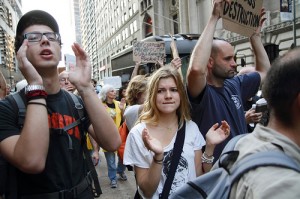Are Latinos Participating In Occupy Wall Street?
 I’ve been watching the coverage of the occupy Wall Street movement — video, pictures — with an eye for color. I’m not there, in New York City, to see for myself so I have to rely on what other people choose to record from what they choose to see. I have only caught a glimpse of a scant few Latinos or blacks in the crowds of folks that are venting their angry frustration at the banking institutions in Lower Manhattan.
I’ve been watching the coverage of the occupy Wall Street movement — video, pictures — with an eye for color. I’m not there, in New York City, to see for myself so I have to rely on what other people choose to record from what they choose to see. I have only caught a glimpse of a scant few Latinos or blacks in the crowds of folks that are venting their angry frustration at the banking institutions in Lower Manhattan.
But I doubted what I saw, because they were second- and third-hand images. Then I read this in the Huffington Post, written by Janell Ross:
With so many African Americans and Latinos out of work and bearing a disproportionate share of the recession’s impact, it would seem that Occupy Wall Street might have particular appeal to people of color. But even Wednesday night, when the Occupy Wall Street movement brought together its original organizers, students and union members who do everything from drive the city’s buses to mop its hospital floors, the crowd remained overwhelmingly white.
Granted, this doesn’t take into account the similar protests in many cities across the country where the Latino and black representation may be larger. For instance, we wrote yesterday about the Occupy LA movement. But the NYC protest has become the flagship, the model to follow, so what doesn’t happen there matters. It may seem like unneeded griping — to gripe against the protesters who are griping against the bankers —but if anyone has a reason to be frustrated it’s Latinos and blacks.
Nearly 40 percent of the nation’s unemployed are African American or Latino. Together, the two groups make up only about 29 percent of the county’s total population but more than 60 percent of the people who live in New York, according to federal data. Nationwide, African Americans and Latinos have also disproportionately lost their homes to foreclosure since the economic downturn began and have seen their assets decline sharply, creating the largest black-white wealth gap in 30 years, according to the Economic Policy Institute.
So what is it? Are Latinos and blacks so marginalized that they don’t even feel part of the group that’s raising a clenched fist against “the man?” Could it be that they’re too busy at work to make time to protest? Or is it that they’re waiting for the movement to figure out what it’s about (it’s hard to identify with something that is in the process of self identification)?
Maybe it’s too early still. Maybe when the protesters gel into a coherent message, which I’m sure will be soon, Latinos and blacks will have a better idea what they’re getting into. Or maybe, as Latinos join the swell of protesters in places like Los Angeles and San Antonio, the momentum will trickle up, to the “occupy” movement’s mother ship.
Either way, the 99% is almost 30% Latino or black. Julianne Malveaux, an economist and president of Bennett College, made the case for the lack of minority representation among the “occupy Wall Street” ranks.
“Progressives frequently are so convinced of their cause and its merits that they don’t do enough to reach out. The problem is if we aren’t there, everybody’s concerns ultimately won’t be addressed.”
The idea is that the economic trails of Latinos and blacks are misunderstood, even among mainstream progressives. Who knows? Maybe when the protesters deliver a more coherent message they’ll capture the hearts and imagination of a wider chunk of the 99%. I’ll keep watching the video and looking at the pictures, to see if the color palate changes.
[Photo by _PaulS_]
